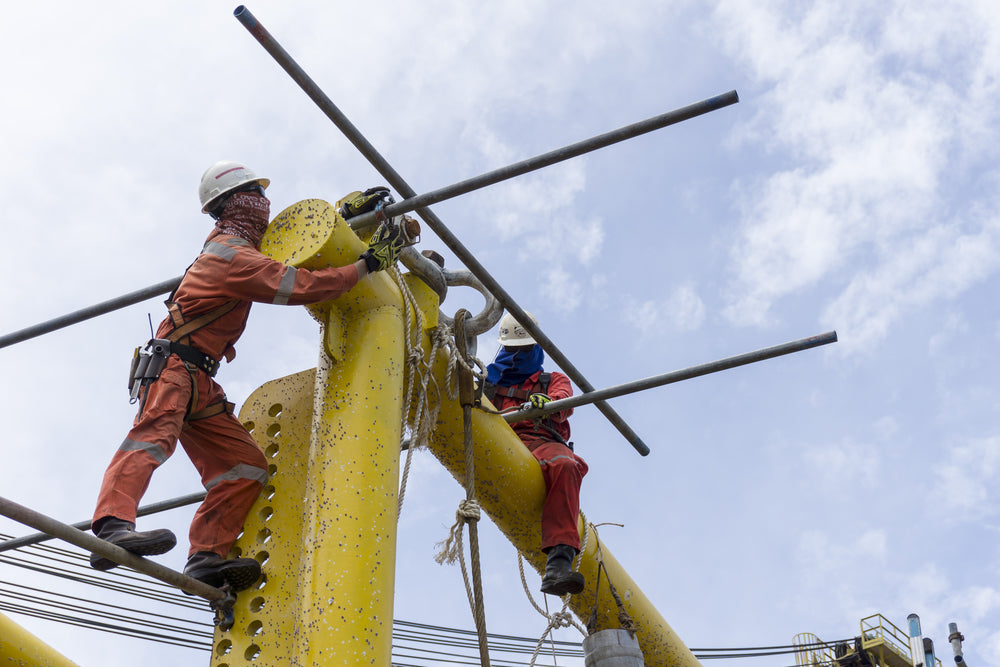CPCCLRG3002 Licence to Perform Rigging Intermediate Level Training Course - Ingleburn, Sydney

CPCCLRG3002 Licence to Perform Rigging Intermediate Level Training Course - Ingleburn, Sydney
Out of stock
Welcome to the CPCCLRG3002 Licence To Perform Rigging Intermediate Training Course. You can apply for the RI High Risk Work Licence once competent.
This NSW-based training course specifies what is needed to perform intermediate rigging duties associated with moving equipment and plant, steel construction and hoists such as mast climbing hoists. It also includes the placement of precast cement, safety nets and static lines, perimeter safety screens and shutters, and safety nets.
After successfully completing the learning activity, the trainer and assessor assesses participants to determine whether they are ready to take their licensing exam, which will be conducted by a High Risk Work (HRW), Assessor.
After completing riggers training, participants have acquired the skills necessary to move, secure, and place loads with mechanical load shifting equipment. Riggers use mechanical equipment to shift loads and related gear in order to move, secure or place loads. This includes plant, equipment, or members of a structure or building. Riggers are responsible for ensuring the stability of these members, and they also set up and take down cranes and hoists.
Participants will be trained on the following areas in relation to intermediate rigging knowledge and skills:
1. Planning tasks
2. Select and inspect rigging gear
3. Set up tasks including correct communication
4. Intermediate rigging activities
5. Completing tasks
The OHS.com.au & Kallibr Training Advantage
- Quality training – our sites replicate real-world construction sites and our clients find that highly valuable.
- Convenience - we run an extensive public course schedule and can also do private courses at your worksite.
- Experience - our trainers are from industry and have typically have decades of practical experience which is critical for high risk work environments
Where will the course be held in Sydney?
Training Provider: Kallibr Training (RTO 32365)
Location: Onsite training (Face to face)
Course length: 35 hours (Approx. 5 Days (4 days training plus 1 day assessment)
Certification / Accreditation: Nationally Recognised Statement of Attainment
Pre-requisites: Participants must have completed the unit of competency CPCCLRG3001 Licence to perform rigging basic level (or equivalent)
Kallibr Training is operating from Brisbane's largest construction training centre.
It is a licenced, insured and accredited RTO (32365). All the instructors have completed their Certificate IV in Training and Assessment and are highly experienced, vocational trainers.
This fully equipped facility is designed to provide the highest quality training. The training facility is located in Salisbury, offering a large array of equipment, structures and plant for construction, high-risk training, and access.
Kallibr Training is operating from Sydney's largest construction training centre.
It is a licenced, insured and accredited RTO (32365). All the instructors have completed their Certificate IV in Training and Assessment and are highly experienced, vocational trainers.
This fully equipped facility is designed to provide the highest quality training. The training facility is located in Ingleburn, offering a large array of equipment, structures and plant for construction, high-risk training, and access.
The Kallibr Training Centre is located at 3a Williamson Rd, Ingleburn NSW 2565
Background: Do You Know The Essentials Of A Intermediate Rigging Training Course In NSW?
Understanding the importance of an intermediate rigging class is crucial for the safety of the workers and the successful completion a project.
This unit specifies the skills and knowledge required to perform intermediate rigging in a safe manner.
Riggers use mechanical load shifting gear, and related gear, to secure or move loads.
This includes structural members, plant, equipment or other items. Riggers install hoists and make sure members are stable.
This unit covers the rigging of structural hoists made from structural steel, pre-cast concrete members, safety nets, static line mast climbing platforms and perimeter safety screens, shutters and screens, as well as cantilevered load platforms.
In the construction industry and other industries, rigging occurs when load shifting equipment (such as a crane) is used to secure or move a load.
The general construction induction program is required for anyone performing construction work. This program is specified by regulators at the state and federal government levels. This requirement can be met by completing the CPCCWHS1001 Prepare to work safely in construction industry and having a White Card.
This unit requires a pre-requisite. This requirement can either be met by successfully completing CPCCLRG3001 License to perform rigging Basic Level (this means you will also have completed a dogging class which is a pre-requisite for CPCCLRG3001).
This unit does not qualify you for a license. After assessing competence under WorkSafe NSW's (WHS) regulations, a license can be obtained through the NSW Government High-Risk Work Licence Service.
It is important to be familiar with the different types rigging hardware that can be used for lifting and moving heavy objects safely.
Understanding how to choose the right hardware based on the load requirements and environmental conditions is essential. Understanding the differences between hardware types will help you to ensure the safety and success of your rigging operation.
|
Hardware Type |
Description |
|
Shackles |
Useful for connecting lifting slings or ropes to chains, chains, or other rigging elements. |
|
Slings |
Flexible straps and cables used to secure and raise loads. |
|
Eyebolts |
Bolts with a looped-head for attaching rigging gear. |
|
Hoists |
Mechanical devices for lifting and lowering heavy items. |
|
Wire Rope Clips |
Use to create an attachment on wire rope. |
NSW Rigger licenses required
- Basic Rigging Work (RB)
- Intermediate rigging work (RI).
- Advanced Rigging Work (RA)
You may need a Rigger's license or Dogger's license if you work in the lift and escalator industry in NSW or anywhere in Australia.
What will you learn from this training course?
-
Interpret and obtain information, such as safe work method statements (SWMSs), to ensure that all activities are performed in accordance with workplace-specific safety requirements.
-
To minimise the risk of falling items, avoid carrying objects on ladders, and minimise manual tasks that are hazardous, identify methods for moving and placing equipment, tools, and materials.
-
Select and check PPE.
-
Select the rigging gear and associated equipment, inspect for defects and isolate, tag-out, report and record defective articles.
-
Maintain communication with all relevant parties to ensure that the task plan and risk control measures are clearly communicated, as well as any impact on other workplace activity.
-
Ascertain that all safety measures and equipment, including fall protection equipment, have been installed, including risk controls, and that they are being used.
-
As per workplace and manufacturer requirements, erect and dismantle structures and operate equipment while maintaining stability.
-
Conduct a multiple-crane lift.
-
Remove excess materials from the work area.
-
Inspection of structures, plant, gear and equipment for defects. Isolate, tag out, and report defective items.
-
Store equipment and plant in accordance with workplace needs.
- Remove safety equipment and risk controls.
Upon successful completion of this course, student will be awarded a Statement of Attainment and the High-Risk Work Licence to Perform Rigging Basic Level by WorkSafe NSW.
Course outcomes
- Statement of Attainment Nationally Recognised.
- Intermediate rigging skills to safely install and dismantle equipment or structures.
- Credit towards a full qualification.
- You can apply for a intermediate rigging licence if you have the required skills.
- Continue your education and improve your career prospects with these strong pathways.
Entry requirements
- A valid basic rigging licence or unit of competency.
- Reached 18 years of age to sit the SafeWork NSW assessment.
- A general construction induction card (commonly known as a white card).
- Proof of current residential address
- 100 points for identification for the SafeWork assessment.
HOW TO APPLY FOR YOUR NEW HIGH RISK LICENCE IN NSW
The application must be submitted within 60 days after the successful completion of the practical assessment.
You can read the rules about applying for a High Risk Work Licence in NSW here.
- Complete your training and be deemed competent
- Complete your application for National Licence to Perform High Risk Work which will be given to you by the RTO and their approved SafeWork NSW Assessor
- You also need your Notice of Satisfactory Assessment (N5 form again provided to you by the RTO approved assessor). This is the original orange and white copy.
- Provide list of 100 points of ID
- A photo (passport quality) with your details written on the back
- Previous licence if you have it
- Go to a participating Australia Post office and apply
- There are fees and charges applicable. See here
You can call SafeWork NSW on 131050 if you have any further questions. Renewals can be done online providing it is not more than 12 months expired.
SKU:
Course Highlights:
- 5 days Face-to-Face
- Expert-Led + Practical
- Quality Focused
- Fast Certification
- Tax Deductable
- Trusted RTO Provider
- Statement of Attainment
- Nationally Recognised
Couldn't load pickup availability

"Well run course! The trainer was very efficient, well prepared, communicated clearly what we would cover and finished on time 👍"
Nathan"Good customer service great knowledge and understanding from the trainers couldn’t recommend a better place to be trained"
Melanie"The course was very informative. Going into the course I didn’t think I’d learn anything new but I was astonished with how much I learnt."
Paul.P"This course was Informative and practical shout out to John for leading the session."
JayADDITIONAL EXTRA BONUSES with OHS.com.au
Claim up to $1271.95 worth of Extra Bonuses
with every purchase
- Your personal copy of Safety Legends E-Book (value $39.95)
- $100 off your first case from Naked Wines (value $100)
- Upto 350,000 Bonus AMEX Frequent Flyer points* (value $1000)
- Complimentary Access to two online courses** (value $132)
$1271.95 EXTRA VALUE - JUST FOR YOU INSIDE!
* New customers when you successfully sign up for a new personal / business credit card ** Indigenous Cultural Awareness / Impacts of Climate Change coursesDescription
Welcome to the CPCCLRG3002 Licence To Perform Rigging Intermediate Training Course. You can apply for the RI High Risk Work Licence once competent.
This NSW-based training course specifies what is needed to perform intermediate rigging duties associated with moving equipment and plant, steel construction and hoists such as mast climbing hoists. It also includes the placement of precast cement, safety nets and static lines, perimeter safety screens and shutters, and safety nets.
After successfully completing the learning activity, the trainer and assessor assesses participants to determine whether they are ready to take their licensing exam, which will be conducted by a High Risk Work (HRW), Assessor.
After completing riggers training, participants have acquired the skills necessary to move, secure, and place loads with mechanical load shifting equipment. Riggers use mechanical equipment to shift loads and related gear in order to move, secure or place loads. This includes plant, equipment, or members of a structure or building. Riggers are responsible for ensuring the stability of these members, and they also set up and take down cranes and hoists.
Participants will be trained on the following areas in relation to intermediate rigging knowledge and skills:
1. Planning tasks
2. Select and inspect rigging gear
3. Set up tasks including correct communication
4. Intermediate rigging activities
5. Completing tasks
The OHS.com.au & Kallibr Training Advantage
- Quality training – our sites replicate real-world construction sites and our clients find that highly valuable.
- Convenience - we run an extensive public course schedule and can also do private courses at your worksite.
- Experience - our trainers are from industry and have typically have decades of practical experience which is critical for high risk work environments
Where will the course be held in Sydney?
Training Provider: Kallibr Training (RTO 32365)
Location: Onsite training (Face to face)
Course length: 35 hours (Approx. 5 Days (4 days training plus 1 day assessment)
Certification / Accreditation: Nationally Recognised Statement of Attainment
Pre-requisites: Participants must have completed the unit of competency CPCCLRG3001 Licence to perform rigging basic level (or equivalent)
Kallibr Training is operating from Brisbane's largest construction training centre.
It is a licenced, insured and accredited RTO (32365). All the instructors have completed their Certificate IV in Training and Assessment and are highly experienced, vocational trainers.
This fully equipped facility is designed to provide the highest quality training. The training facility is located in Salisbury, offering a large array of equipment, structures and plant for construction, high-risk training, and access.
Kallibr Training is operating from Sydney's largest construction training centre.
It is a licenced, insured and accredited RTO (32365). All the instructors have completed their Certificate IV in Training and Assessment and are highly experienced, vocational trainers.
This fully equipped facility is designed to provide the highest quality training. The training facility is located in Ingleburn, offering a large array of equipment, structures and plant for construction, high-risk training, and access.
The Kallibr Training Centre is located at 3a Williamson Rd, Ingleburn NSW 2565
Background: Do You Know The Essentials Of A Intermediate Rigging Training Course In NSW?
Understanding the importance of an intermediate rigging class is crucial for the safety of the workers and the successful completion a project.
This unit specifies the skills and knowledge required to perform intermediate rigging in a safe manner.
Riggers use mechanical load shifting gear, and related gear, to secure or move loads.
This includes structural members, plant, equipment or other items. Riggers install hoists and make sure members are stable.
This unit covers the rigging of structural hoists made from structural steel, pre-cast concrete members, safety nets, static line mast climbing platforms and perimeter safety screens, shutters and screens, as well as cantilevered load platforms.
In the construction industry and other industries, rigging occurs when load shifting equipment (such as a crane) is used to secure or move a load.
The general construction induction program is required for anyone performing construction work. This program is specified by regulators at the state and federal government levels. This requirement can be met by completing the CPCCWHS1001 Prepare to work safely in construction industry and having a White Card.
This unit requires a pre-requisite. This requirement can either be met by successfully completing CPCCLRG3001 License to perform rigging Basic Level (this means you will also have completed a dogging class which is a pre-requisite for CPCCLRG3001).
This unit does not qualify you for a license. After assessing competence under WorkSafe NSW's (WHS) regulations, a license can be obtained through the NSW Government High-Risk Work Licence Service.
It is important to be familiar with the different types rigging hardware that can be used for lifting and moving heavy objects safely.
Understanding how to choose the right hardware based on the load requirements and environmental conditions is essential. Understanding the differences between hardware types will help you to ensure the safety and success of your rigging operation.
|
Hardware Type |
Description |
|
Shackles |
Useful for connecting lifting slings or ropes to chains, chains, or other rigging elements. |
|
Slings |
Flexible straps and cables used to secure and raise loads. |
|
Eyebolts |
Bolts with a looped-head for attaching rigging gear. |
|
Hoists |
Mechanical devices for lifting and lowering heavy items. |
|
Wire Rope Clips |
Use to create an attachment on wire rope. |
NSW Rigger licenses required
- Basic Rigging Work (RB)
- Intermediate rigging work (RI).
- Advanced Rigging Work (RA)
You may need a Rigger's license or Dogger's license if you work in the lift and escalator industry in NSW or anywhere in Australia.
What will you learn from this training course?
-
Interpret and obtain information, such as safe work method statements (SWMSs), to ensure that all activities are performed in accordance with workplace-specific safety requirements.
-
To minimise the risk of falling items, avoid carrying objects on ladders, and minimise manual tasks that are hazardous, identify methods for moving and placing equipment, tools, and materials.
-
Select and check PPE.
-
Select the rigging gear and associated equipment, inspect for defects and isolate, tag-out, report and record defective articles.
-
Maintain communication with all relevant parties to ensure that the task plan and risk control measures are clearly communicated, as well as any impact on other workplace activity.
-
Ascertain that all safety measures and equipment, including fall protection equipment, have been installed, including risk controls, and that they are being used.
-
As per workplace and manufacturer requirements, erect and dismantle structures and operate equipment while maintaining stability.
-
Conduct a multiple-crane lift.
-
Remove excess materials from the work area.
-
Inspection of structures, plant, gear and equipment for defects. Isolate, tag out, and report defective items.
-
Store equipment and plant in accordance with workplace needs.
- Remove safety equipment and risk controls.
Upon successful completion of this course, student will be awarded a Statement of Attainment and the High-Risk Work Licence to Perform Rigging Basic Level by WorkSafe NSW.
Course outcomes
- Statement of Attainment Nationally Recognised.
- Intermediate rigging skills to safely install and dismantle equipment or structures.
- Credit towards a full qualification.
- You can apply for a intermediate rigging licence if you have the required skills.
- Continue your education and improve your career prospects with these strong pathways.
Entry requirements
- A valid basic rigging licence or unit of competency.
- Reached 18 years of age to sit the SafeWork NSW assessment.
- A general construction induction card (commonly known as a white card).
- Proof of current residential address
- 100 points for identification for the SafeWork assessment.
HOW TO APPLY FOR YOUR NEW HIGH RISK LICENCE IN NSW
The application must be submitted within 60 days after the successful completion of the practical assessment.
You can read the rules about applying for a High Risk Work Licence in NSW here.
- Complete your training and be deemed competent
- Complete your application for National Licence to Perform High Risk Work which will be given to you by the RTO and their approved SafeWork NSW Assessor
- You also need your Notice of Satisfactory Assessment (N5 form again provided to you by the RTO approved assessor). This is the original orange and white copy.
- Provide list of 100 points of ID
- A photo (passport quality) with your details written on the back
- Previous licence if you have it
- Go to a participating Australia Post office and apply
- There are fees and charges applicable. See here
You can call SafeWork NSW on 131050 if you have any further questions. Renewals can be done online providing it is not more than 12 months expired.
- Money Back Guarantee
- Save Time & Money
- Tax Deductible
- 1000's Trained Each Month
- Quality-Focused
- Peer Reviewed Courses
- Trusted Industry Partner
- Fast Certification
- 60 Day Guarantee
- *See refund policy


Got multiple people needing to do a course? We will get back to you within a day!
Student Reviews

Couldn't load pickup availability

Contact Us!
Contact form
ADDITIONAL EXTRA BONUSES with OHS.com.au
Claim up to $1271.95 worth of Extra Bonuses
with every purchase
- Your personal copy of Safety Legends E-Book (value $39.95)
- $100 off your first case from Naked Wines (value $100)
- Upto 350,000 Bonus AMEX Frequent Flyer points* (value $1000)
- Complimentary Access to two online courses** (value $132)
$1271.95 EXTRA VALUE - JUST FOR YOU INSIDE!
* New customers when you successfully sign up for a new personal / business credit card ** Indigenous Cultural Awareness / Impacts of Climate Change coursesDescription
Welcome to the CPCCLRG3002 Licence To Perform Rigging Intermediate Training Course. You can apply for the RI High Risk Work Licence once competent.
This NSW-based training course specifies what is needed to perform intermediate rigging duties associated with moving equipment and plant, steel construction and hoists such as mast climbing hoists. It also includes the placement of precast cement, safety nets and static lines, perimeter safety screens and shutters, and safety nets.
After successfully completing the learning activity, the trainer and assessor assesses participants to determine whether they are ready to take their licensing exam, which will be conducted by a High Risk Work (HRW), Assessor.
After completing riggers training, participants have acquired the skills necessary to move, secure, and place loads with mechanical load shifting equipment. Riggers use mechanical equipment to shift loads and related gear in order to move, secure or place loads. This includes plant, equipment, or members of a structure or building. Riggers are responsible for ensuring the stability of these members, and they also set up and take down cranes and hoists.
Participants will be trained on the following areas in relation to intermediate rigging knowledge and skills:
1. Planning tasks
2. Select and inspect rigging gear
3. Set up tasks including correct communication
4. Intermediate rigging activities
5. Completing tasks
The OHS.com.au & Kallibr Training Advantage
- Quality training – our sites replicate real-world construction sites and our clients find that highly valuable.
- Convenience - we run an extensive public course schedule and can also do private courses at your worksite.
- Experience - our trainers are from industry and have typically have decades of practical experience which is critical for high risk work environments
Where will the course be held in Sydney?
Training Provider: Kallibr Training (RTO 32365)
Location: Onsite training (Face to face)
Course length: 35 hours (Approx. 5 Days (4 days training plus 1 day assessment)
Certification / Accreditation: Nationally Recognised Statement of Attainment
Pre-requisites: Participants must have completed the unit of competency CPCCLRG3001 Licence to perform rigging basic level (or equivalent)
Kallibr Training is operating from Brisbane's largest construction training centre.
It is a licenced, insured and accredited RTO (32365). All the instructors have completed their Certificate IV in Training and Assessment and are highly experienced, vocational trainers.
This fully equipped facility is designed to provide the highest quality training. The training facility is located in Salisbury, offering a large array of equipment, structures and plant for construction, high-risk training, and access.
Kallibr Training is operating from Sydney's largest construction training centre.
It is a licenced, insured and accredited RTO (32365). All the instructors have completed their Certificate IV in Training and Assessment and are highly experienced, vocational trainers.
This fully equipped facility is designed to provide the highest quality training. The training facility is located in Ingleburn, offering a large array of equipment, structures and plant for construction, high-risk training, and access.
The Kallibr Training Centre is located at 3a Williamson Rd, Ingleburn NSW 2565
Background: Do You Know The Essentials Of A Intermediate Rigging Training Course In NSW?
Understanding the importance of an intermediate rigging class is crucial for the safety of the workers and the successful completion a project.
This unit specifies the skills and knowledge required to perform intermediate rigging in a safe manner.
Riggers use mechanical load shifting gear, and related gear, to secure or move loads.
This includes structural members, plant, equipment or other items. Riggers install hoists and make sure members are stable.
This unit covers the rigging of structural hoists made from structural steel, pre-cast concrete members, safety nets, static line mast climbing platforms and perimeter safety screens, shutters and screens, as well as cantilevered load platforms.
In the construction industry and other industries, rigging occurs when load shifting equipment (such as a crane) is used to secure or move a load.
The general construction induction program is required for anyone performing construction work. This program is specified by regulators at the state and federal government levels. This requirement can be met by completing the CPCCWHS1001 Prepare to work safely in construction industry and having a White Card.
This unit requires a pre-requisite. This requirement can either be met by successfully completing CPCCLRG3001 License to perform rigging Basic Level (this means you will also have completed a dogging class which is a pre-requisite for CPCCLRG3001).
This unit does not qualify you for a license. After assessing competence under WorkSafe NSW's (WHS) regulations, a license can be obtained through the NSW Government High-Risk Work Licence Service.
It is important to be familiar with the different types rigging hardware that can be used for lifting and moving heavy objects safely.
Understanding how to choose the right hardware based on the load requirements and environmental conditions is essential. Understanding the differences between hardware types will help you to ensure the safety and success of your rigging operation.
|
Hardware Type |
Description |
|
Shackles |
Useful for connecting lifting slings or ropes to chains, chains, or other rigging elements. |
|
Slings |
Flexible straps and cables used to secure and raise loads. |
|
Eyebolts |
Bolts with a looped-head for attaching rigging gear. |
|
Hoists |
Mechanical devices for lifting and lowering heavy items. |
|
Wire Rope Clips |
Use to create an attachment on wire rope. |
NSW Rigger licenses required
- Basic Rigging Work (RB)
- Intermediate rigging work (RI).
- Advanced Rigging Work (RA)
You may need a Rigger's license or Dogger's license if you work in the lift and escalator industry in NSW or anywhere in Australia.
What will you learn from this training course?
-
Interpret and obtain information, such as safe work method statements (SWMSs), to ensure that all activities are performed in accordance with workplace-specific safety requirements.
-
To minimise the risk of falling items, avoid carrying objects on ladders, and minimise manual tasks that are hazardous, identify methods for moving and placing equipment, tools, and materials.
-
Select and check PPE.
-
Select the rigging gear and associated equipment, inspect for defects and isolate, tag-out, report and record defective articles.
-
Maintain communication with all relevant parties to ensure that the task plan and risk control measures are clearly communicated, as well as any impact on other workplace activity.
-
Ascertain that all safety measures and equipment, including fall protection equipment, have been installed, including risk controls, and that they are being used.
-
As per workplace and manufacturer requirements, erect and dismantle structures and operate equipment while maintaining stability.
-
Conduct a multiple-crane lift.
-
Remove excess materials from the work area.
-
Inspection of structures, plant, gear and equipment for defects. Isolate, tag out, and report defective items.
-
Store equipment and plant in accordance with workplace needs.
- Remove safety equipment and risk controls.
Upon successful completion of this course, student will be awarded a Statement of Attainment and the High-Risk Work Licence to Perform Rigging Basic Level by WorkSafe NSW.
Course outcomes
- Statement of Attainment Nationally Recognised.
- Intermediate rigging skills to safely install and dismantle equipment or structures.
- Credit towards a full qualification.
- You can apply for a intermediate rigging licence if you have the required skills.
- Continue your education and improve your career prospects with these strong pathways.
Entry requirements
- A valid basic rigging licence or unit of competency.
- Reached 18 years of age to sit the SafeWork NSW assessment.
- A general construction induction card (commonly known as a white card).
- Proof of current residential address
- 100 points for identification for the SafeWork assessment.
HOW TO APPLY FOR YOUR NEW HIGH RISK LICENCE IN NSW
The application must be submitted within 60 days after the successful completion of the practical assessment.
You can read the rules about applying for a High Risk Work Licence in NSW here.
- Complete your training and be deemed competent
- Complete your application for National Licence to Perform High Risk Work which will be given to you by the RTO and their approved SafeWork NSW Assessor
- You also need your Notice of Satisfactory Assessment (N5 form again provided to you by the RTO approved assessor). This is the original orange and white copy.
- Provide list of 100 points of ID
- A photo (passport quality) with your details written on the back
- Previous licence if you have it
- Go to a participating Australia Post office and apply
- There are fees and charges applicable. See here
You can call SafeWork NSW on 131050 if you have any further questions. Renewals can be done online providing it is not more than 12 months expired.
- Money Back Guarantee
- Save Time & Money
- Tax Deductible
- 1000's Trained Each Month
- Quality-Focused
- Peer Reviewed Courses
- Trusted Industry Partner
- Fast Certification
- 60 Day Guarantee
- *See refund policy
Student Reviews

Course Highlights:
- 5 days Face-to-Face
- Expert-Led + Practical
- Quality Focused
- Fast Certification
- Tax Deductable
- Trusted RTO Provider
- Statement of Attainment
- Nationally Recognised
Couldn't load pickup availability

"Well run course! The trainer was very efficient, well prepared, communicated clearly what we would cover and finished on time 👍"
Nathan"Good customer service great knowledge and understanding from the trainers couldn’t recommend a better place to be trained"
Melanie"The course was very informative. Going into the course I didn’t think I’d learn anything new but I was astonished with how much I learnt."
Paul.P"This course was Informative and practical shout out to John for leading the session."
Jay



Are you from a large organisation? Contact us for a group quote!
 Checkout securely with
Checkout securely with
With experience in the training industry since 1999, OHS is a trusted provider of online health and safety training, dedicated to delivering practical solutions in a field that often overlooks the value of vocational education. With our training programs, we aim to make training accessible and affordable, allowing people who need to refresh their knowledge to do so without committing a great deal of time.
Making sure everyone can easily pursue professional development, we've engineered our training programs at OHS, such as NDIS Training, Safety Training, Staff Training and VOCs/High Risk Refreshers, to be as adaptable as they are cost-effective. You won't have to keep searching for terms like 'Hr Classes', 'First Aid Training Lethbridge' or 'First Response First Aid Training'; we've streamlined access to essential knowledge.
At OHS, you can purchase courses individually or subscribe yearly to get unlimited access to our extensive training library. Don't waste time searching for 'induction training','awareness training' or 'free online courses australia' - buy a course or make an enquiry today!
 1300 307 445
1300 307 445


